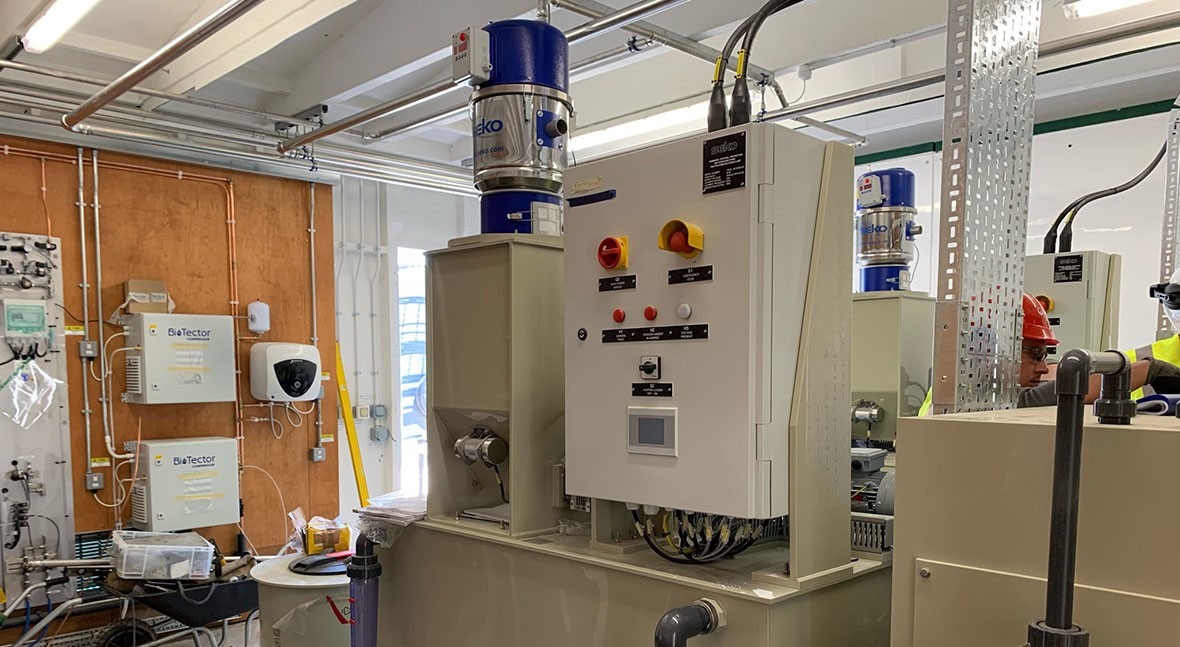Wastewater treatment solution for a critical airport application

When a leading utilities and services provider was commissioned to create an environmentally-critical application for one of the world’s busiest airports, they collaborated with water-treatment expert SEKO for a failsafe solution.
The European airport handles in excess of 80 million passengers each year, and among the huge number of logistical challenges management faces in order to ensure the safe and efficient operation is managing the effect of cold weather on aircraft.
Large-scale de-icing avoids flight cancellations
During winter, the presence of snow and ice disrupts airflow over wings and the tail of an aircraft, hindering its ability to create lift and consequently preventing pilots from taking off.
In order to avoid the delay or cancellation of potentially hundreds of flights and the subsequent disruption to travellers, the airport invested in de-icing cannons in order to spray airliners with a heated glycol fluid. This process ensured that settled snow and ice melted, while preventing further build-up once planes were airborne.
A commitment to minimizing environmental impact
However, the airport was concerned that wastewater from this process could contaminate waterways with glycol, having a devastating effect on surrounding waterborne wildlife. With up to 1,000 litres of de-icer required to clear an Airbus A380, and hundreds of flights departing daily, the pollution risk was significant.

The airport, having a clear vision for sustainable growth, had worked hard for many years to reduce its environmental impact, meaning any contamination incident would be a significant setback with the resulting negative publicity damaging its public profile.
The airport, having a clear vision for sustainable growth, had worked hard for many years to reduce its environmental impact
Airport management, therefore, commissioned a leading utilities provider to build and operate treatment works adjacent to the site in order to improve the quality of wastewater being discharged.
When designing the plant, the utilities company decided to treat the wastewater via a flocculation process, whereby contaminated particles in liquid clump together and eventually sink, allowing them to be separated and the remaining clean water safely discharged.
Looking for a proven solution capable of handling this complex and demanding process, water-treatment dosing and control specialist SEKO was approached to supply an automated polymer batching system that could separate pollutants and allow treated water to be safely discharged into a nearby watercourse.
Following an extensive assessment of the site and application, SEKO recommended its PolyCendos polymer preparation unit (PPU) in order to automatically dose up to 200 litres of wastewater per second with flocculant.
Safety, reliability and performance in one
PolyCendos is an all-in-one system for the preparation of polymer solutions, supplied complete with an IP65-rated electric control panel, dosing pumps and powder feeder.
PolyCendos is an all-in-one system for polymer solutions, with an IP65-rated electric control panel, dosing pumps and powder feeder
The unit has three chambers for dissolving, maturing and storage which are interconnected by syphons, forming a perfect flow necessary for the formation of a high-quality solution. The chambers include inspection covers and emptying valves and are made entirely in PPH for excellent chemical resistance and a low-friction surface.
PolyCendos’ comprehensive safety features include a safety pressure switch for the automatic water supply system, an emergency stop for all components and a separate safety level switch for overflow levels.

How PolyCendos works
- Operators tip powdered polymer into a hopper from 20 kg bags, ensuring compliance with manual handling regulations. When the level of prepared solution falls below the minimum level, an alarm indicates that the powder tank must be replenished.
- The powdered polymer enters the system via a stainless-steel batching screw – managed by a precise speed regulator – and mixes with water before the resulting solution drops into tank one below and the dissolving phase begins. A customized stainless-steel agitator slowly and continuously turns the contents of the tank, ensuring thorough homogenization of the solution.
The siphon transfers the solution to the maturing chamber, where another slow agitator keeps the mixture uniform until maturing is complete.
The solution is transferred to a storage chamber from where it can be transferred for use. When this tank is full, the powder dosing pump automatically stops and the water inlet is closed, preventing further solution from being batched.
Two motor-driven PS2 Spring series pumps dose the polymer solution into the wastewater, with flow-rate adjustment performed automatically by an Aktua control unit, which can be calibrated during operation for maximum efficiency.

Some of the client’s site management were not always present, so being able to remotely view and adjust dosage was a huge benefit
With this water-treatment system, airport management could guarantee the quality of its discharged water and protect local wildlife
Meanwhile, SEKO also supplied its Spring pumps coupled with Elektra digital controllers for the precise dosing of anti foam – commonly required in wastewater processes. Elektra’s revolutionary ‘data on demand’ technology meant users could control anti-foam dosing from any location via PC, laptop or smart device.
Because some of the client’s site management operated multiple plants and were not always present at the airport, being able to remotely view and adjust dosage was a huge benefit. With this comprehensive water-treatment system in place, airport management could guarantee the quality of its discharged water, protect local wildlife and enhance its drive towards sustainable growth.
Another example of a SEKO solution helping customers achieve long-term, cost-effective improvements in their daily operations.


